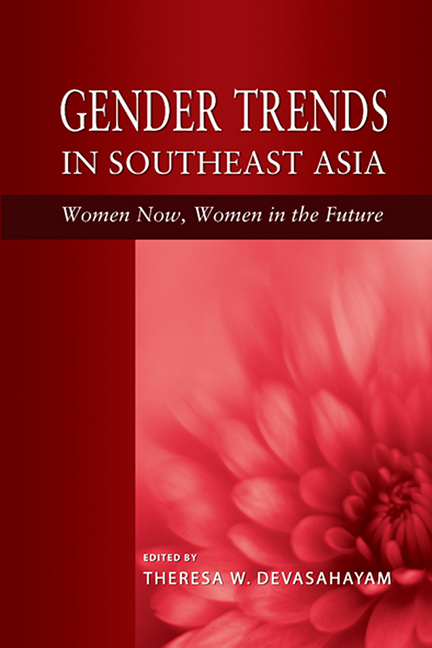Book contents
- Frontmatter
- Contents
- Contributors
- List of Tables and Figures
- Foreword
- Message
- Acknowledgements
- 1 Introduction: Women in Southeast Asia: Changes and Continuities
- 2 Women, Marriage and Family in Southeast Asia
- 3 Gender Trends in Migration and Employment in Southeast Asia
- 4 Has Gender Analysis been Mainstreamed in the Study of Southeast Asian Politics?
- 5 Gender Mainstreaming in Health: Mainstream or “Off-Stream”?
- 6 Politicization of Islam in Indonesia and Malaysia: Women's Rights and Inter-Religious Relations
- Index
3 - Gender Trends in Migration and Employment in Southeast Asia
Published online by Cambridge University Press: 21 October 2015
- Frontmatter
- Contents
- Contributors
- List of Tables and Figures
- Foreword
- Message
- Acknowledgements
- 1 Introduction: Women in Southeast Asia: Changes and Continuities
- 2 Women, Marriage and Family in Southeast Asia
- 3 Gender Trends in Migration and Employment in Southeast Asia
- 4 Has Gender Analysis been Mainstreamed in the Study of Southeast Asian Politics?
- 5 Gender Mainstreaming in Health: Mainstream or “Off-Stream”?
- 6 Politicization of Islam in Indonesia and Malaysia: Women's Rights and Inter-Religious Relations
- Index
Summary
INTRODUCTION
Labour migration is generally nothing new in Southeast Asia. However in recent decades, changes in the contexts and causes of mobility are due to the enormously reduced importance of geographical distances in determining boundaries of labour markets. This is largely as a result of improved transport and communication technologies and the role of ‘globalization’ in promoting the decline of a number of barriers, including institutional ones, to the rapid movement of capital, labour and information.
Migration in Southeast Asia has become an important process of globalization in which flows of people — increasingly women — move from rural to urban areas, from one region to the next, and across national borders in the context of growing ‘global cities’, and new urban and peri-urbanizing spaces in response to rapid industrialization.
A number of factors explain the exponential growth in female labour migration: the growth of formal and informal economies in the services sector and tourism industry in the region has created job opportunities for women, in addition to employment in garment and textile industries across national borders. Southeast Asian migrant women usually originate from countries with a relatively high female labour force participation rate. Hardship, especially in the rural areas, induces these women to employ labour migration as a means to survive. Additionally, there are relatively few cultural constraints in Southeast Asia that might constrain the mobility of women and, social networks have greatly sustained and intensified the nature of female migration. Significantly, women have responded to labour markets that specifically demand that they perform their feminized roles of care. This chapter will explore how the notion of feminized work has shaped international and urban-based migrant labour regimes, leading to greater informalization and flexibilization of migrant women's work across Southeast Asia. The governing premise in this chapter is that women do not do unskilled or low-skilled jobs because they are naturally bearers of inferior labour. Rather, the jobs they do are unskilled because women enter them already determined as inferior labourers (Pearson 1997).
- Type
- Chapter
- Information
- Gender Trends in Southeast AsiaWomen Now, Women in the Future, pp. 31 - 52Publisher: ISEAS–Yusof Ishak InstitutePrint publication year: 2009

